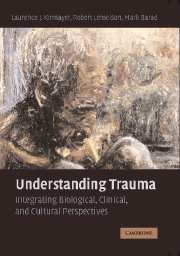Book contents
- Frontmatter
- Contents
- List of Figures
- List of Tables
- List of Contributors
- Foreword by Robert Jay Lifton
- Preface
- List of Abbreviations
- Introduction: Inscribing Trauma in Culture, Brain, and Body
- SECTION I NEUROBIOLOGICAL PERSPECTIVES ON TRAUMA
- SECTION II CLINICAL PERSPECTIVES ON TRAUMA
- 8 Cognitive Behavioral Treatments for Posttraumatic Stress Disorder
- 9 PTSD Among Traumatized Refugees
- 10 PTSD: A Disorder of Recovery?
- 11 The Developmental Impact of Childhood Trauma
- 12 Adaptation, Ecosocial Safety Signals, and the Trajectory of PTSD
- 13 Religion and Spirituality After Trauma
- 14 Posttraumatic Suffering as a Source of Transformation: A Clinical Perspective
- SECTION III CULTURAL PERSPECTIVES ON TRAUMA
- Epilogue: Trauma and the Vicissitudes of Interdisciplinary Integration
- Glossary
- Index
- References
9 - PTSD Among Traumatized Refugees
Published online by Cambridge University Press: 27 July 2009
- Frontmatter
- Contents
- List of Figures
- List of Tables
- List of Contributors
- Foreword by Robert Jay Lifton
- Preface
- List of Abbreviations
- Introduction: Inscribing Trauma in Culture, Brain, and Body
- SECTION I NEUROBIOLOGICAL PERSPECTIVES ON TRAUMA
- SECTION II CLINICAL PERSPECTIVES ON TRAUMA
- 8 Cognitive Behavioral Treatments for Posttraumatic Stress Disorder
- 9 PTSD Among Traumatized Refugees
- 10 PTSD: A Disorder of Recovery?
- 11 The Developmental Impact of Childhood Trauma
- 12 Adaptation, Ecosocial Safety Signals, and the Trajectory of PTSD
- 13 Religion and Spirituality After Trauma
- 14 Posttraumatic Suffering as a Source of Transformation: A Clinical Perspective
- SECTION III CULTURAL PERSPECTIVES ON TRAUMA
- Epilogue: Trauma and the Vicissitudes of Interdisciplinary Integration
- Glossary
- Index
- References
Summary
Since 1977, the Intercultural Psychiatric Program (formally the Indochinese Psychiatric Program) of the Oregon Health and Science University has been treating refugees from Southeast Asia, that is, Vietnam, Cambodia, and Laos (Kinzie, Tran, Breckenridge, & Bloom, 1980). Over the years, the program has grown to include refugees and immigrants from Russia, Bosnia, Central America, Somalia, Ethiopia, Iran, Afghanistan, and the Kurdish areas of Central Asia. Our clinical method has been consistent over this time. Each patient has one counselor from his or her own ethnic group and one psychiatrist. The counselor acts as an interpreter, case manager, and usually a socialization group leader. The psychiatrist provides the initial evaluation, diagnostic formulation, psychotherapy, and medication management (Kinzie, 1981). Typically, a counselor–psychiatrist team will follow from 50 to 100 patients. As of 2004, the program had 1100 active patients with Vietnamese comprising the largest group. Cambodians, Russians, and Bosnians also were strongly represented. Overall, the program staff have the ability to translate 17 different languages.
Beginning with the Cambodians in 1981 (Kinzie, Fredrickson, Ben, Fleck, & Karls, 1984), we became aware through their psychiatric histories of the massive trauma suffered by these refugees. This prompted us to take more systematic trauma histories from other refugee groups, and we found a high rate in all groups (Kinzie et al., 1990). As civil wars, ethnic cleansing, and tribal violence continued throughout the world, successive waves of refugees coming to the United States became patients in our program.
- Type
- Chapter
- Information
- Understanding TraumaIntegrating Biological, Clinical, and Cultural Perspectives, pp. 194 - 206Publisher: Cambridge University PressPrint publication year: 2007
References
- 16
- Cited by

